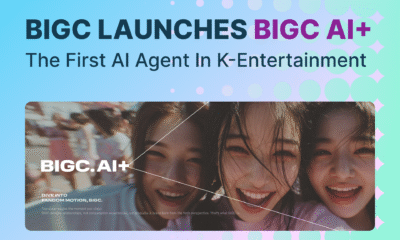Tools & Platforms
S. Korea launches W150tr bet to up ante in AI tech race

Lee to hold news conference Thursday, marking 100th day in office
South Korea on Wednesday unveiled plans to bet big on the growth of artificial intelligence, semiconductors, biotechnology, defense, robots and green mobility to up the ante in the global race for strategic technologies.
Under the plan, a massive investment fund worth 150 trillion won ($108.1 billion) will be pooled over the next five years, and the plan will create up to 125 trillion won worth of added value in South Korea’s economy, according to the government.
Amid a slowdown in Korea’s economic growth due to heated international competition for technologies, President Lee Jae Myung stressed the need to secure a new engine for growth.
“Major countries like the United States and China are ramping up their state support to strategic industries backed by cutting-edge technologies,” Lee said at the event he hosted in Seoul before some 150 participants on Wednesday. “We are engaged in a war without gun smoke.”
Lee also said the scale of the pooled fund was later confirmed to be 1.5 times larger than the initially set 100 trillion won, according to the policy blueprint suggested by the de facto transition team for Lee, the State Affairs Planning Committee.
Half of the pooled fund will stem from a 75 trillion won fund newly established by the state-run policy lender Korea Development Bank. The government projected KDB’s fund to launch in December following the promulgation of relevant legislation on Tuesday. KDB will join forces with government ministries to explore investment destinations.
The rest of the fund will comprise contributions from South Korean pension funds and financial institutions, as well as individual citizens.
The fund will invest in securities of late-stage venture firms with technology prowess, investment vehicles that invest in such securities, low-interest loans, as well as large-scale infrastructure such as AI expressways and data centers, according to the government.
The destinations for investment will be businesses related to artificial intelligence, semiconductor chips, biotechnology, vaccines, defense equipment, robots, hydrogen energy, secondary batteries, display panels and futuristic mobility, according to the government.
The investment fund will also open the way for South Korea’s “grand transition to productive finance,” Lee said.
“We will take advantage of the growth opportunity and share its fruits with citizens,” Lee said, adding that the newly established fund could alleviate the chronic overheating of the housing market and banks’ reliance on lending rates.
Meanwhile, Lee is poised to hold a news conference Thursday at 10 a.m. Marking his 100th day in office, the conference will be the second of its kind since his inauguration in June.
Some 150 journalists from Korea and abroad will take part in the conference, which will center on economics, social affairs and culture, said Lee Kyu-youn, senior presidential secretary for public relations and communication, in a briefing on Wednesday.
consnow@heraldcorp.com
Tools & Platforms
Is AI Going to Replace Nurses?

AI will redefine nursing practice, not replace it, says this CNE.
People all over the country are holding their breath to see how AI will impact the workforce, and in healthcare it’s no different.
AI comes with many promises of care efficiency and cost savings, with the side effect of anxiety about job security and potential displacement. In nursing, the stakes are even higher, with concerns about patient safety and privacy at the forefront.
In 2025 alone, there have been several nursing strikes that have centered concerns about AI, including a National Nurses United march involving 100,000 members who were calling for safe staffing and protections against AI and other untested technologies.
However, from one leader’s perspective, AI will be additive in nursing, not a replacement.
“The hope is that it’s going to be a plus one, and I think that we as nursing leaders really need to ensure that we are at the front of all of this,” said Terry McDonnell, senior vice president and chief nurse executive at Duke University Health System. “We need to be vetting, developing, engaging with industry partners, engaging with operational partners, and we also have to make sure that we bring our staff along with us and have them as part of the conversation.”
The reality of AI in nursing
According to McDonnell, the biggest misconception about AI is that it’s going to replace nursing jobs.
“The reality is that AI has been in healthcare for a very long time, but now it’s to a point where it’s accelerating at a pace that we need to keep up with,” McDonnell said, “and I think we’re always going to need human interaction and high-level human processing.”
One of the primary ways that nurses will use AI is for decision support.
“Gone will be the days of searching long for policies and literature,” McDonnell said. “AI actually helps us sift through a lot of information very quickly.”
AI also allows nurses to be proactive with things like computer vision and algorithms that help notify nurses if a patient is at risk of falling while getting out of bed. With AI in use, nurses won’t have to be physically in the room to know what’s going on with their patients.
“Imagine a world where there’s cameras in a room. It’s part of the normal care setting, and based on algorithms, the nurse will get a notification that a patient might be trying to get out of bed, and they might be at risk for a fall,” McDonnell said. “The nurse can then intervene long before the patient’s on the floor.”
Redefined, not replaced
For CNOs who want to help quell fears among nurses that AI might replace their jobs, McDonnell recommends education and including nurses in the process.
“We’re doing a lot of development here at Duke and we’re letting our frontline nurses be part of the vetting, the development, and the creation of those solutions,” McDonnell said. “It’s really about making sure that people understand what we’re talking about when we talk about AI solutions and tools, and having them be a part of the conversation and not having it be something that gets imposed upon them.”
As AI progresses in the industry, there is plenty of potential for developing nurse-led models of care, McDonnell explained. AI will change care delivery, improve outcomes, and decrease falls and infections.
“It’s going to be interesting to see how we adapt these tools,” McDonnell said, “and how these tools can then help care providers, nurses, physicians, nurse practitioners, and PAs actually be able to focus more and give more of that human interaction that everybody’s been missing as we’ve been trying to do more with the same amount of resources.”
AI also has a bright future in the preventative care space, according to McDonnell, especially when paired with remote patient monitoring and hospital at home technology.
“We know that people do better from infection risk and from recovery when they’re in their home setting,” McDonnell said. “I think with these tools, we’re going to be able to keep people safe in their homes and get them through with remote monitoring.”
For CNOs who are feeling intimidated by implementing AI in their health systems, McDonnell recommends avoiding the narrative that AI is going to take away nursing jobs.
“Embrace [AI], be curious, and learn what the capability is,” McDonnell said, “and most importantly, ensure that your staff and your patients are part of the discussion.”
G Hatfield is the CNO editor for HealthLeaders.
Tools & Platforms
Why Qwen3 Next Is the Most Efficient AI Model Yet

What if the future of artificial intelligence wasn’t just about being smarter, but also leaner, faster, and more adaptable? Enter Qwen3 Next, a new AI model that challenges the notion that bigger is always better. With an astonishing 80 billion parameters at its core, it achieves high-performance results while activating just a fraction of its potential during inference. This isn’t just a technical feat, it’s a paradigm shift. Imagine an AI capable of rivaling the giants while consuming a fraction of the computational resources. In a world where efficiency often feels like an afterthought, Qwen3 Next flips the script, proving that innovation and practicality can go hand in hand.
In this feature, Sam Witteveen pulls back the curtain on what makes Qwen3 Next a true fantastic option. From its hybrid attention mechanisms to its sparse inference architecture, every design choice reflects a bold vision for the future of AI. You’ll discover how this model not only redefines benchmarks but also sets the stage for scalable, multilingual, and agentic capabilities that adapt to the demands of a rapidly evolving world. Whether you’re intrigued by its ability to predict multiple tokens simultaneously or its promise of cost-effective performance, Qwen3 Next offers a glimpse into what’s next for artificial intelligence. After all, the future isn’t just about building bigger, it’s about building smarter.
Qwen3 Next Overview
TL;DR Key Takeaways :
- Qwen3 Next is an 80-billion-parameter mixture-of-experts (MoE) AI model that activates only 3 billion parameters during inference, achieving high performance with reduced computational demands.
- Key innovations include a hybrid attention mechanism, sparse inference activating just 3.7% of parameters, and a 512-expert architecture for precision and adaptability across tasks.
- The model supports multi-token prediction and speculative decoding, allowing faster and more efficient inference for time-sensitive applications.
- Trained on 15 trillion tokens from a 36 trillion token corpus, Qwen3 Next delivers scalable performance while minimizing resource usage, with potential for further optimization.
- It offers multilingual and agentic capabilities, excelling in reasoning, tool use, and multi-step workflows, while setting new benchmarks in the global AI landscape with its innovative design.
Core Innovations That Define Qwen3 Next
Qwen3 Next introduces a suite of new features that distinguish it from other AI models. These innovations not only enhance its functionality but also set new benchmarks for the design and application of future AI systems.
- Hybrid Attention Mechanism: This advanced mechanism optimizes how the model processes information, improving its ability to handle complex tasks efficiently. It also serves as a blueprint for future proprietary AI systems.
- Sparse Inference: By activating only 3.7% of its parameters during inference, Qwen3 Next achieves remarkable speed and resource efficiency without compromising on performance, making it a cost-effective solution for diverse applications.
- Mixture-of-Experts Architecture: With 512 specialized experts, the model excels at managing a wide variety of tasks, offering unparalleled precision and adaptability across different domains.
These features collectively ensure that Qwen3 Next not only meets but exceeds expectations for efficiency, scalability, and performance, making it a standout in the competitive AI landscape.
Enhanced Inference with Multi-Token Prediction
A defining feature of Qwen3 Next is its ability to predict multiple tokens simultaneously, significantly accelerating the inference process. This capability allows for faster and more efficient generation of results, making it particularly valuable in time-sensitive applications. Additionally, the model incorporates speculative decoding, a innovative technique that improves decoding efficiency while maintaining high levels of accuracy. These advancements align with the latest research trends, making sure that Qwen3 Next remains at the forefront of AI development and continues to deliver practical benefits for users.
Qwen3 Next : Behind the Curtain
Here are more detailed guides and articles that you may find helpful on Qwen AI models.
Efficient Training for Scalable Performance
Qwen3 Next was trained on 15 trillion tokens derived from a 36 trillion token corpus, achieving exceptional performance while minimizing computational costs. This efficient training process not only reduces resource usage but also leaves room for further optimization. Extending the training to the full corpus could unlock even greater potential, making Qwen3 Next a scalable and future-ready solution. For you, this translates to a model that is both powerful and adaptable, capable of evolving to meet increasingly complex demands.
Benchmark Excellence and Versatility
Qwen3 Next consistently outperforms its predecessors and rivals larger models across a wide range of benchmarks. It is available in two distinct versions—“thinking” and “instruct”—each tailored to specific use cases. The “thinking” version excels in advanced reasoning tasks, while the “instruct” version is optimized for task-specific instructions. This dual approach ensures that Qwen3 Next delivers consistent, reliable results, offering the flexibility to address diverse requirements effectively.
Multilingual and Agentic Capabilities
Designed with global applications in mind, Qwen3 Next is capable of processing and generating responses in multiple languages. While its internal reasoning primarily occurs in English, its multilingual capabilities make it adaptable to various linguistic contexts. This versatility is further enhanced by its agentic abilities, which include tool use, function calling, and multi-step reasoning. These features empower you to tackle complex workflows with confidence, allowing efficient problem-solving and decision-making in diverse scenarios.
Redefining the Global AI Landscape
The development of Qwen3 Next underscores the innovation and openness of Chinese AI labs, setting a new benchmark in the global AI ecosystem. Its design choices, such as sparse inference and multi-token prediction, challenge competitors to rethink their strategies and adapt to the rapidly evolving landscape. For example, organizations like Meta may need to incorporate similar advancements to remain competitive. By pushing the boundaries of what AI can achieve, Qwen3 Next not only redefines current standards but also shapes the trajectory of future AI development.
A Vision for the Future
Qwen3 Next is more than just an AI model, it represents a forward-thinking vision for the future of artificial intelligence. By combining innovation, efficiency, and performance, it sets a new standard for what AI systems can accomplish. Whether you are exploring multilingual processing, using agentic capabilities, or optimizing computational resources, Qwen3 Next offers a robust and adaptable solution. It addresses today’s challenges while anticipating the demands of tomorrow, making sure that you remain at the forefront of technological progress.
Media Credit: Sam Witteveen
Latest Geeky Gadgets Deals
Disclosure: Some of our articles include affiliate links. If you buy something through one of these links, Geeky Gadgets may earn an affiliate commission. Learn about our Disclosure Policy.
Tools & Platforms
Is Google Gemini Nano Banana AI tool safe: Privacy, watermarks and other safety concerns that experts warn

Google launched Gemini Nano Banana AI tool last month. It has now taken the inetrnet by storm with users creating 3D figurines to Gemini Nano Banana AI Saree trend on Instagram with users turning their ordinary photos into dramatic 90s Bollywood-style portraits. The trend, however, has sparked fresh warnings about privacy and security risks linked to uploading personal images online.
What is Nano Banana AI trend: From 3D figurines to vintage sarees
The “Nano Banana” craze, powered by Google’s Gemini Nano model, allows users to transform selfies into stylised 3D figurine portraits with glossy skin and exaggerated features. Building on its popularity, a new variant — the “Banana AI Saree” trend is making waves on Meta’s Instagram that reimagines portraits in retro Bollywood-inspired saree looks, often featuring chiffon drapes, cinematic backdrops and vintage textures.
Is using Google Gemini Nano Banana safe
Google says images created with Gemini carry an invisible watermark known as SynthID, along with metadata tags, to help verify AI-generated content. “All images created or edited with Gemini 2.5 Flash Image include an invisible SynthID digital watermark to clearly identify them as AI-generated. Build with confidence and provide transparency for your users,” information on aistudio.google.com states.However, detection tools for SynthID are not yet available to the public. Experts also point out that watermarks can be tampered with. A report by Wired quoted Ben Colman, CEO of Reality Defender, as saying: “Watermarking at first sounds like a noble and promising solution but its real-world applications fail from the onset when they can be easily faked, removed or ignored.”Hany Farid, professor at the UC Berkeley School of Information, told Wired that watermarking has potential but is not a standalone safeguard: “Some experts think watermarking can help in AI detection but its limitations need to be understood. Nobody thinks watermarking alone will be sufficient.”
Indian police officer’s advisory on use of Google Gemini Nano Banana
Indian Police Service officer VC Sajjanar has also cautioned users about risks tied to the Nano Banana trend. In a post on X, Sajjanar said “Be cautious with trending topics on the internet! Falling into the trap of the ‘Nano Banana’ craze can be risky. If you share personal information online, scams are bound to happen. With just one click, the money in your bank accounts can end up in the hands of criminals” (translated).He also urged users to avoid fake websites or unofficial apps mimicking Gemini’s platform: “Once your data reaches a fake website, retrieving it becomes very difficult. Your data, your money — your responsibility.”
How to safely use Google Gemini Nano Banana
Experts recommend that users take precautions before engaging with viral AI tools. These include avoiding the upload of sensitive or private photos, stripping metadata such as location tags, and tightening privacy settings on social media. Limiting where and how images are shared can also reduce the risk of misuse.
-

 Business2 weeks ago
Business2 weeks agoThe Guardian view on Trump and the Fed: independence is no substitute for accountability | Editorial
-
Tools & Platforms1 month ago
Building Trust in Military AI Starts with Opening the Black Box – War on the Rocks
-

 Ethics & Policy2 months ago
Ethics & Policy2 months agoSDAIA Supports Saudi Arabia’s Leadership in Shaping Global AI Ethics, Policy, and Research – وكالة الأنباء السعودية
-

 Events & Conferences4 months ago
Events & Conferences4 months agoJourney to 1000 models: Scaling Instagram’s recommendation system
-

 Jobs & Careers3 months ago
Jobs & Careers3 months agoMumbai-based Perplexity Alternative Has 60k+ Users Without Funding
-

 Podcasts & Talks2 months ago
Podcasts & Talks2 months agoHappy 4th of July! 🎆 Made with Veo 3 in Gemini
-

 Education3 months ago
Education3 months agoVEX Robotics launches AI-powered classroom robotics system
-

 Education2 months ago
Education2 months agoMacron says UK and France have duty to tackle illegal migration ‘with humanity, solidarity and firmness’ – UK politics live | Politics
-

 Funding & Business3 months ago
Funding & Business3 months agoKayak and Expedia race to build AI travel agents that turn social posts into itineraries
-

 Podcasts & Talks2 months ago
Podcasts & Talks2 months agoOpenAI 🤝 @teamganassi



















